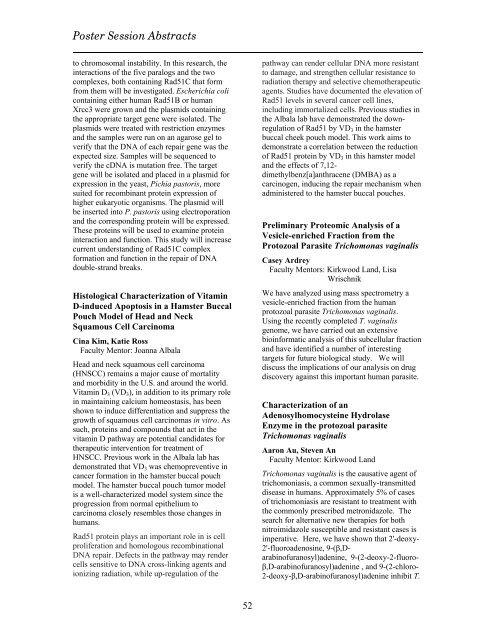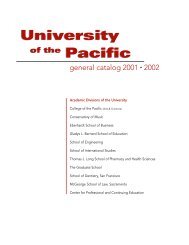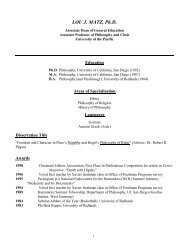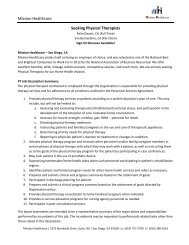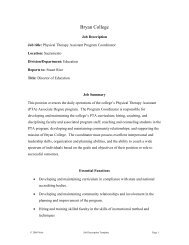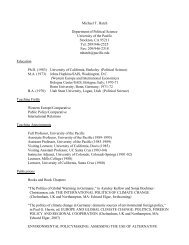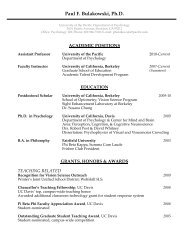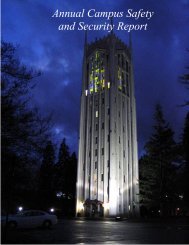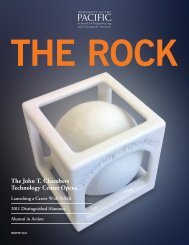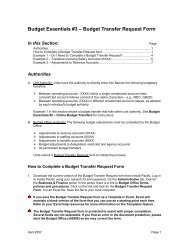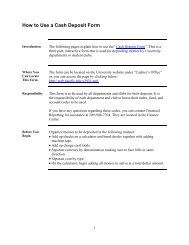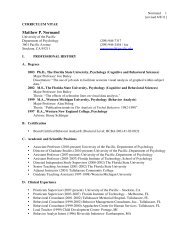purcc 2012 - University of the Pacific
purcc 2012 - University of the Pacific
purcc 2012 - University of the Pacific
You also want an ePaper? Increase the reach of your titles
YUMPU automatically turns print PDFs into web optimized ePapers that Google loves.
Poster Session Abstracts<br />
to chromosomal instability. In this research, <strong>the</strong><br />
interactions <strong>of</strong> <strong>the</strong> five paralogs and <strong>the</strong> two<br />
complexes, both containing Rad51C that form<br />
from <strong>the</strong>m will be investigated. Escherichia coli<br />
containing ei<strong>the</strong>r human Rad51B or human<br />
Xrcc3 were grown and <strong>the</strong> plasmids containing<br />
<strong>the</strong> appropriate target gene were isolated. The<br />
plasmids were treated with restriction enzymes<br />
and <strong>the</strong> samples were run on an agarose gel to<br />
verify that <strong>the</strong> DNA <strong>of</strong> each repair gene was <strong>the</strong><br />
expected size. Samples will be sequenced to<br />
verify <strong>the</strong> cDNA is mutation free. The target<br />
gene will be isolated and placed in a plasmid for<br />
expression in <strong>the</strong> yeast, Pichia pastoris, more<br />
suited for recombinant protein expression <strong>of</strong><br />
higher eukaryotic organisms. The plasmid will<br />
be inserted into P. pastoris using electroporation<br />
and <strong>the</strong> corresponding protein will be expressed.<br />
These proteins will be used to examine protein<br />
interaction and function. This study will increase<br />
current understanding <strong>of</strong> Rad51C complex<br />
formation and function in <strong>the</strong> repair <strong>of</strong> DNA<br />
double-strand breaks.<br />
Histological Characterization <strong>of</strong> Vitamin<br />
D-induced Apoptosis in a Hamster Buccal<br />
Pouch Model <strong>of</strong> Head and Neck<br />
Squamous Cell Carcinoma<br />
Cina Kim, Katie Ross<br />
Faculty Mentor: Joanna Albala<br />
Head and neck squamous cell carcinoma<br />
(HNSCC) remains a major cause <strong>of</strong> mortality<br />
and morbidity in <strong>the</strong> U.S. and around <strong>the</strong> world.<br />
Vitamin D 3 (VD 3 ), in addition to its primary role<br />
in maintaining calcium homeostasis, has been<br />
shown to induce differentiation and suppress <strong>the</strong><br />
growth <strong>of</strong> squamous cell carcinomas in vitro. As<br />
such, proteins and compounds that act in <strong>the</strong><br />
vitamin D pathway are potential candidates for<br />
<strong>the</strong>rapeutic intervention for treatment <strong>of</strong><br />
HNSCC. Previous work in <strong>the</strong> Albala lab has<br />
demonstrated that VD 3 was chemopreventive in<br />
cancer formation in <strong>the</strong> hamster buccal pouch<br />
model. The hamster buccal pouch tumor model<br />
is a well-characterized model system since <strong>the</strong><br />
progression from normal epi<strong>the</strong>lium to<br />
carcinoma closely resembles those changes in<br />
humans.<br />
Rad51 protein plays an important role in is cell<br />
proliferation and homologous recombinational<br />
DNA repair. Defects in <strong>the</strong> pathway may render<br />
cells sensitive to DNA cross-linking agents and<br />
ionizing radiation, while up-regulation <strong>of</strong> <strong>the</strong><br />
pathway can render cellular DNA more resistant<br />
to damage, and streng<strong>the</strong>n cellular resistance to<br />
radiation <strong>the</strong>rapy and selective chemo<strong>the</strong>rapeutic<br />
agents. Studies have documented <strong>the</strong> elevation <strong>of</strong><br />
Rad51 levels in several cancer cell lines,<br />
including immortalized cells. Previous studies in<br />
<strong>the</strong> Albala lab have demonstrated <strong>the</strong> downregulation<br />
<strong>of</strong> Rad51 by VD 3 in <strong>the</strong> hamster<br />
buccal cheek pouch model. This work aims to<br />
demonstrate a correlation between <strong>the</strong> reduction<br />
<strong>of</strong> Rad51 protein by VD 3 in this hamster model<br />
and <strong>the</strong> effects <strong>of</strong> 7,12-<br />
dimethylbenz[a]anthracene (DMBA) as a<br />
carcinogen, inducing <strong>the</strong> repair mechanism when<br />
administered to <strong>the</strong> hamster buccal pouches.<br />
Preliminary Proteomic Analysis <strong>of</strong> a<br />
Vesicle-enriched Fraction from <strong>the</strong><br />
Protozoal Parasite Trichomonas vaginalis<br />
Casey Ardrey<br />
Faculty Mentors: Kirkwood Land, Lisa<br />
Wrischnik<br />
We have analyzed using mass spectrometry a<br />
vesicle-enriched fraction from <strong>the</strong> human<br />
protozoal parasite Trichomonas vaginalis.<br />
Using <strong>the</strong> recently completed T. vaginalis<br />
genome, we have carried out an extensive<br />
bioinformatic analysis <strong>of</strong> this subcellular fraction<br />
and have identified a number <strong>of</strong> interesting<br />
targets for future biological study. We will<br />
discuss <strong>the</strong> implications <strong>of</strong> our analysis on drug<br />
discovery against this important human parasite.<br />
Characterization <strong>of</strong> an<br />
Adenosylhomocysteine Hydrolase<br />
Enzyme in <strong>the</strong> protozoal parasite<br />
Trichomonas vaginalis<br />
Aaron Au, Steven An<br />
Faculty Mentor: Kirkwood Land<br />
Trichomonas vaginalis is <strong>the</strong> causative agent <strong>of</strong><br />
trichomoniasis, a common sexually-transmitted<br />
disease in humans. Approximately 5% <strong>of</strong> cases<br />
<strong>of</strong> trichomoniasis are resistant to treatment with<br />
<strong>the</strong> commonly prescribed metronidazole. The<br />
search for alternative new <strong>the</strong>rapies for both<br />
nitroimidazole susceptible and resistant cases is<br />
imperative. Here, we have shown that 2'-deoxy-<br />
2'-fluoroadenosine, 9-(β,Darabin<strong>of</strong>uranosyl)adenine,<br />
9-(2-deoxy-2-fluoroβ,D-arabin<strong>of</strong>uranosyl)adenine<br />
, and 9-(2-chloro-<br />
2-deoxy-β,D-arabin<strong>of</strong>uranosyl)adenine inhibit T.<br />
52


